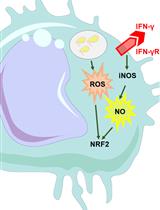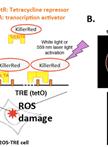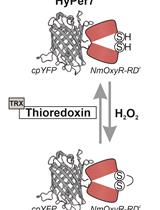- EN - English
- CN - 中文
Detection of Intracellular Reactive Oxygen Species (CM-H2DCFDA)
细胞内活性氧的检测(CM-H2DCFDA)
发布: 2013年01月05日第3卷第1期 DOI: 10.21769/BioProtoc.313 浏览次数: 89774

相关实验方案

使用荧光酶标仪连续测量受细菌感染的骨髓源性巨噬细胞中活性氧的生成
Natascha Brigo [...] Christa Pfeifhofer-Obermair
2023年02月05日 2422 阅读
Abstract
Reactive oxygen species (ROS) play a critical role in cellular physiopathology. ROS are implicated in cell proliferation, signaling pathways, oxidative defense mechanisms responsible for killing of bacteria, thyroid hormonosynthesis, etc. The cellular Redox homeostasis is balanced by oxidants and antioxidants systems. In several diseases (cancer, neurodegenerative diseases, cardiovascular diseases), the Redox balance is disturbed. In fact, excessive amounts of ROS can damage proteins, lipids and DNA at cellular level.
The choose of a sensitive method for detection of intracellular ROS is very important for detecting the disturbed Redox balance in pathological cells and after exposition of cells to different genotoxic agents (Irradiation, Oxidative stress, etc).
The detection of ROS in biological systems is difficult for several reasons: Method sensibility and probe specificity. The 2′, 7′-dichlorodihydrofluorescein diacetate (H2DCF-DA) fluorescent probe is commonly employed and may react with several ROS including hydrogen peroxide, hydroxyl radicals and peroxynitrite. The cell-permeant H2DCFDA passively diffuses into cells and is retained in the intracellular level after cleavage by intracellular esterases. Upon oxidation by ROS, the nonfluorescent H2DCFDA is converted to the highly fluorescent 2',7'-dichlorofluorescein (DCF). The chloromethyl derivative of H2DCFDA (CM-H2DCFDA) provides much better retention in live cells than H2DCFDA. Dead or dying cells produces ROS. When we want to detect ROS in living cells, we have to stain cells by propidium iodide (PI) and evaluate ROS production only in living cells which are PI negative. In fact, PI intercalates into double-stranded nucleic acids. It is excluded by viable cells but can penetrate cell membranes of dying or dead cells. PI is excited at 488 nm and emits at a maximum wavelength of 617 nm. Because of these spectral characteristics, PI can be used in combination with other fluorescent probe such as CM-H2DCFDA (excitation/emission: 492–495/517–527 nm).
A probe fluorescence emission can be assessed by Flow cytometry, a standard fluorometer or fluorescence microscopy using appropriate filter.
Flow cytometry is commonly employed to detect intracellular ROS production. Flow cytometry measures fluorescence per cell. The cells is excited by the light source and emitted light from cells are converted to electrical pulses by optical detectors. Emitted Light is send to different detectors by using optical filters: 525 nm Band Pass Filter for FL-1 and 620 nm Band Pass Filter for FL-3. A 525 nm band pass filter (FL-1) placed in the light path prior to the detector will only allow “green” light into the detector. So, FL-1 is used in our protocol to collect green light corresponding to the oxidation of dichlorodihydrofluorescein (DCF) by ROS. FL-1 is the Green (FL-1) channel on flow cytometers. 620 nm Band Pass Filter (FL-3) only allow “red” light into the detector. Red fluorescence emission is measured in the Red (FL-3) channel on most flow cytometers.
Materials and Reagents
- 1x Trypsin-EDTA (0.05% / 0.02% in PBS) (PAA Laboratories GmbH, catalog number: L11-004 )
- DPBS, Calcium, Magnesium (Life Technologies, InvitrogenTM, catalog number: 14040 )
- HBSS Hank’s Balanced Salt Solution (HBSS) with Calcium and Magnesium and without Red Phenol (Life Technologies, InvitrogenTM, catalog number: 14025 )
- CM-H2DCFDA (Life Technologies, InvitrogenTM, catalog number: C6827 )
- Propidium Iodide - 1.0 mg/ml (Life Technologies, InvitrogenTM, catalog number: P3566 )
Equipment
- Cell incubator
- Six-well plates
- Centrifuge
- FACSVantage SE (Becton Dickinson)
- 2 x 75 mm, 5 ml polystyrene round bottom test tube (BD Biosciences, catalog number: 352054 )
Procedure
文章信息
版权信息
© 2013 The Authors; exclusive licensee Bio-protocol LLC.
如何引用
Ameziane-El-Hassani, R. and Dupuy, C. (2013). Detection of Intracellular Reactive Oxygen Species (CM-H2DCFDA). Bio-protocol 3(1): e313. DOI: 10.21769/BioProtoc.313.
分类
细胞生物学 > 细胞染色 > 活性氧
生物化学 > 其它化合物 > 活性氧
您对这篇实验方法有问题吗?
在此处发布您的问题,我们将邀请本文作者来回答。同时,我们会将您的问题发布到Bio-protocol Exchange,以便寻求社区成员的帮助。
Share
Bluesky
X
Copy link











